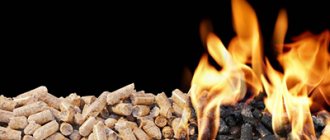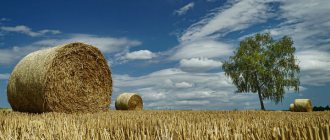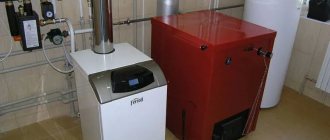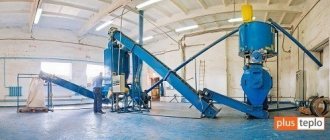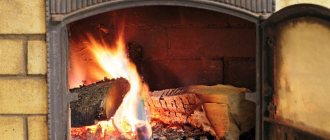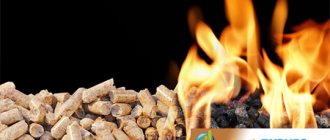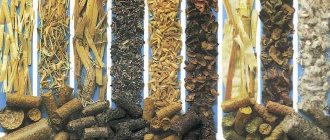Pellets as a fuel type
Pellets - the main fuel for pellet boilers - are made from crushed sawdust, waste from the wood processing industry and agro-industry.
Pellets, depending on the raw materials from which they are made, have different calorific value. Because of this circumstance, manufacturers do not indicate the consumption of pellets in the instructions and passports for pellet boilers - the calorific value of pellets may be too different, which means that to obtain the same power, different quantities will be required.
For example, peat pellets have a high calorific value - more than 21 MJ/kg, class A1 pellets (from coniferous trees) are characterized by a calorific value of more than 16.5 MJ/kg.
Pellets made from a variety of materials are available on the market:
All types of pellets have different calorific values. Conscientious pellet manufacturers indicate it in quality certificates and composition analysis reports. If there are none, then the calorific value of pellets can only be reliably established experimentally.
Comparative characteristics of fuel types
First, about the price of energy resources. The table shows the cost of fuel at Moscow prices:
| Raw materials for pellets | Cost from 20 tons with shipment from warehouse | Price from 1 ton with shipment from warehouse |
| Sunflower husk pellets | From $50 (3300 rub.) per 1 ton | From $70 (4500 rub.) per 1 ton |
| Wood light pellets from 6 mm | From $100 (6500 rub.) per 1 ton | From $105 (6800 rub.) per 1 ton |
| Wood light pellets from 8 mm | From $95 (6000 rub.) per 1 ton | From $100 (6500 rub.) per 1 ton |
| Birch briquettes | From $90 (5800 rub.) per 1 ton | From $95 (6000 rub.) per 1 ton. |
Comparative characteristics of fuel costs:
The use of granular energy carriers is noticeably more profitable than the use of traditional types of raw materials. However, the costs of maintaining the equipment will be higher, but this figure is offset by savings when purchasing briquetted raw materials.
How much does it cost to heat a house with pellets?
The cost per ton of pellets varies and depends on the region, quality, and raw materials from which the pellets are made.
Let’s take pellets from the same supplier, for which we calculated the pellet consumption per month:
Purchasing 1 ton of pellets from coniferous trees in the largest container will cost 7,900 rubles.
Let's calculate how much 1 kg of pellets will cost: 7900 / 1000 = 7.9 rubles
Let's calculate how much 1 kW of these pellets costs: 0.19 (kg) * 7.9 (rub) = 1.5 rubles
Let's calculate how much it will cost to heat a house with an area of 100 m2 per day at maximum consumption:
50.7 (kg, consumption per day) * 7.9 (rub) = 400.53 rubles
1500 (kg, consumption per month) * 7.9 (rub) = 11850 rubles
Let's summarize the data in a table:
table 2
| Cost 1 kW | 1.5 rub. |
| Cost of 1 kg of softwood pellets | 7.9 rub. |
| The cost of heating a house of 100 m2 per day at maximum pellet consumption | RUB 400.53 |
| The cost of heating a house of 100 m2 per month at maximum pellet consumption | 11850 rub. |
Let us emphasize once again - these are the figures at maximum flow, as if the boiler was working without interruption 24/7. In reality, the consumption will be less, and therefore the cost. But how much can only be determined experimentally or by doing a thermal calculation.
Rules for selecting and determining the quality of granular energy carriers
The quality of the pellets affects the cost of pellets; on average, pine fuel is estimated at $90 (6,200 rubles) per 1 ton, peat briquetted pellets from $85 (5,700 rubles) per thousand kilograms. Also, the cost may depend on the prevalence and availability of a particular raw material, but on average the difference does not amount to more than 500 rubles.
Selecting quality raw materials is the main task of the owner. The better the granular fuel, the higher the functionality of the heating system and all equipment.
To distinguish good fuel from bad, you need to pay attention to some nuances:
- Presence of dust. If there is a lot of dust in a bag of pellets, the pellets are overdried, so they crumble and crumble - this is a minus. Chips, defects and dents on briquettes also indicate poor quality of the product.
- Uneven color. The shade should be uniform without obvious areas of lightening or darkening. If the granules have taken on a gray tint, are swollen or cracked, they have been lying around for a long time and have lost some of their beneficial properties.
- Size. European standard length 25 mm. Small deviations in the direction of increase and decrease are allowed; this does not affect the overall quality of combustion.
- Smell. The fuel must have the aroma of raw materials with a hint of sweetness, which appears during the drying and processing process. The smells of rot, burning, chemicals are a minus.
You can check the purity of the raw materials just by smell - sunflower pellets smell like oil, wood - sawdust, peat - smoke.
Rating of quality pellets for heating 2022
Starting price category
Fuel pellets 2022 (oak)
As the name suggests, the fuel presented here is from a foreign manufacturer (Poland), based on oak wood. A distinctive feature of the product is its quality, the absence of third-party hazardous fractions, and a small release of waste after burning. The environmental friendliness of the product expands its possible applications. This makes it possible to heat a private home, heat a bathhouse, or use it as cat litter. The relatively low price, considering imported products, is considered a plus. Therefore, if the selection criteria are the optimal price-quality ratio, you should pay attention to Fuel pellets 2022 (oak).
Fuel pellets 2022 (oak)
Advantages:
- Wide functionality;
- Compliance with European environmental standards;
- Quality of composition;
- Heat dissipation.
Flaws:
- No.
Gardener's Empire (conifers)
By producing this fuel, the manufacturing company managed to achieve a high density of fractions, as a result of which the combustion process occurs slowly, measuredly, with high heat transfer. Coniferous wood is usually used to make furniture, and the waste is thrown away. Since they are not suitable for smoking products or frying over an open fire, being saturated with a large amount of resins. Therefore, the price of pine chips is quite low. Accordingly, the maximum cost of a package weighing 15 kilograms is 300 rubles. However, the spread of coniferous briquettes is limited by the high resin content. Therefore, “Gardener’s Empire” is suitable only for specialized heating systems designed for coniferous raw materials.
Gardener's Empire (conifers)
Advantages:
- Dense structure simplifies storage and transportation;
- Two types of packaging: 15, 30 kilograms;
- Burns out slowly;
- Good heat dissipation;
- The most inexpensive granules;
- No toxicity.
Flaws:
- Afraid of moisture.
Kuzmich 24 (pine)
The rating of inexpensive products is completed by a brand that occupies a mid-price position between the two brands mentioned above. It is more expensive than domestic analogs, being cheaper than the cheapest imported options. Using pine as a base, the fuel cylinders are the same size, structure, white in color with small inclusions. This indicates the quality of the product, worthy of the heat dissipation of the material, earning the best user reviews. Kuzmich 24 can be used for almost all types of solid fuel heating systems, baths, and fireplaces.
Kuzmich 24 (pine)
Advantages:
- Pressing quality;
- Price;
- Decent heat dissipation;
- No toxicity.
Flaws:
- Packed in 25 kilograms only.
Average price category
Wood technologies
When creating the presented fuel, the manufacturing company takes as a basis the material of trees, both coniferous and deciduous. Moreover, the manufacturer’s size varies from 6 to 10 millimeters, thereby allowing it to be used for different boiler room loading systems. Thanks to the combination of tree species, the resulting granulate has an ash content of about 0.5%, is not afraid of moisture and stress, facilitating transportation and storage.
Wood technology pellets
Advantages:
- Variety of packaging, sizes;
- Unpretentious to storage conditions;
- Ash percentage after combustion.
Flaws:
- Low heat transfer for this segment.
Gardener's Empire (hay)
The advantage of the Gardener's Empire is its versatility, which allows the presented product to be used as bedding, food for farm animals and some domestic animals, and fertilizer in gardening. The hay base burns long enough, as a result of which it can be used as a fuel corresponding to its status.
Gardener's Empire (hay)
Advantages:
- No toxic impurities;
- Multifunctionality of application;
- Decent burn time.
Flaws:
- Increased sensitivity to moisture.
Grillkoff Pellets (aspen, spruce, pine)
The vast majority of product components consist of coniferous waste, including tree bark, which determines the performance properties. Thus, the composition has an affordable price category, a specific smell (suitable for pine needle lovers), and a wide range of applications for private use for industrial purposes. The latter is possible thanks to packaging bags weighing 30 kilograms. For example, if a user is wondering which is the best cat litter to buy, then Grillkoff would be a good option. After all, 30 kilograms of jelly beans will last a long time, and the smell of pine needles will overpower the amber. Considering the price, about 600 rubles, the product is of interest to those who care about how much the filler costs.
Grillkoff Pellets (aspen, spruce, pine)
Advantages:
- Packaging size;
- Price;
- No toxic impurities.
Flaws:
- The smell of pine needles is not for everyone.
Highest price category
Mesquite BROIL KING
Reading the description of the products listed above, you can notice a purely economic predisposition - heating, filling cat litter, use as fertilizer. However, cooking food, grilling, barbecuing is impossible or not recommended. BROIL KING mesquite allows you to cook over an open fire without fear, because the company’s products have undergone strict environmental control. Moreover, Mesquite BROIL KING is not afraid of humidity, which is convenient when organizing picnics or grilling in an open kitchen. An undoubted advantage of BROIL KING Mesquite will be the spicy aroma it emits, which can give the prepared dishes a special taste.
Mesquite BROIL KING
Advantages:
- High environmental production standards;
- Multifunctional application.
Flaws:
- Price.
WEBER Hickory 190102
New products on the multifunctional pellet market are granules that have a pleasant pecan aroma. When preparing shish kebab or barbecue, WEBER Hickory 190102 will imbue dishes with an unobtrusive nutty aroma. It will be pleasant if you use pellets to heat a fireplace or open hearth. The European manufacturer guarantees compliance with quality standards and environmental friendliness, which justifies the cost of fuel.
WEBER Hickory 190102
Advantages:
- Pleasant pecan aroma;
- High environmental production standards;
- Multifunctional application.
Flaws:
- The packaging is opaque, it is impossible to judge the integrity of the granules.
Oklahoma Joe's
As the name implies, American-made pellets, which consist of a blend of sawdust from different tree species. The blend is based on cherry, maple and hickory. Accordingly, Oklahoma Joe's is used as fuel, grill ignition, barbecue, and even for smoking food. Moreover, smoking is more comfortable compared to using regular wood or gas. After all, Oklahoma Joe's energy efficiency is 5500 kW. This range of possibilities and product characteristics somewhat justify the price of about 2,000 rubles for a medium-sized package.
Oklahoma Joe's
Advantages:
- Wide functionality;
- Workmanship.
Flaws:
- Price;
- The packaging is opaque, it is impossible to judge the integrity of the granules.
Classification of granular fuel
The technological map of classes divides energy carriers into the following types:
- White. They are made from high-quality dried wood, cleared of bark. High class fuel with low ash content (up to 0.5%) is used in any solid fuel boilers. Heat transfer averages 17.2 megajoules (MJ) per 1 kg of raw materials. Clean the ash pan chamber no more than once every 4-6 weeks.
- Industrial. The raw material mass may contain dust, grant, bark and other impurities. Increased ash content, heat production 7.2 MJ/1kg. The ash pan needs to be cleaned once every 3-5 days; exact data on boiler maintenance is prescribed in the accompanying technical documents for the fuel.
- Agropellets. Classified as standard, the raw materials are sunflower and buckwheat husks. Dark color, reduced thermal efficiency (up to 15 MJ/1 kg), high ash content - disadvantages. The fuel is inexpensive, so it is often used in boilers with automatic cleaning in industrial regions where pellets are more accessible. Fuel is also used for home systems, but the ash pan will have to be cleaned daily.
Advice! When choosing pellet heating, you need to pay attention to the availability of fuel. In regions with extensive agricultural land, agropellets are cheaper, and in areas with peat bogs it is more convenient to buy granulated peat raw materials.
Main types of pellet burners for burning granules
Special burners are used to burn pellets. Each option has its own design features. But the fuel is supplied to the system in the same way. As the auger rotates, granules that come from the hopper are poured into the burner. There is a pipe between the burner and the auger that prevents reverse draft.
Types of burners:
- Flare;
- Retort;
- Fireplace.
The flare system involves supplying fuel using a hydrolysis auger directly into the firebox. Air is supplied through it. This creates a powerful flame.
Any type of fuel is used for flare burners. That's why they are so popular.
In a retort design, the flame is directed from below and the pellets are directed upward. There is ventilation on the side through which air enters the burner. The disadvantages of retort burners are their large size, the complexity of the technology, the need to maintain a slope and use only high-quality fuel.
Characteristics and features of pellets
Defining what pellets are, we can describe the product as waste from industrial processes of wood processing, processing of coal, peat, and agricultural crops. Briquettes are formed under pressure of more than 300 atmospheres at high temperatures.
The raw materials are mixed, processed, passed through molds, resulting in capsules or granules. Gluing particles does not require the use of artificial adhesives, natural lignin is sufficient, so heating a house with pellets is the cleanest and safest from an environmental point of view. The thickness of the granules can be 6-10 mm, length 20-30 mm. The peculiarity of using pellets is their increased thermal efficiency. Compared to other types of raw materials, 1000 kg of pellets will replace 500 kg of diesel, 480 m3 of gas, 1600 kg of firewood.
On a note! The property of 100% combustion and low ash content will help you make a choice in favor of pellets. The price of raw materials is higher than that of firewood, but when choosing sawn birch firewood, pellets turn out to be more profitable, even if you take wooden pallets for heating of the highest class of cleanliness.
Some manufacturers produce granules from solid waste. Granules are very cheap, do not differ in thermal efficiency, but are suitable as a reserve supply for heating a house during the off-season or late spring frosts.
Weather thermostat for heating boiler control
Types and raw materials used
If we classify pellets by grade, then there are three types:
- Industrial — have a gray-brown color, their ash content is higher than 0.7. This is explained by the fact that the wood from which they are made has not been debarked. That is, a large amount of bark gets into the granules, giving an increased percentage of ash content. It is worth considering that the use of industrial pellets in a domestic boiler can lead to its breakdown: not all burners can operate with fuel with a high ash content. But they can cost 50% less, and this is a decent saving. If your boiler burns this type of pellets without any problems, you can use them, but you will have to clean it more often.
Industrial pellets cannot always be used in domestic boilers - Agropellets. Obtained from agricultural waste. They are quite cheap, but their main disadvantage is that they contain a large amount of ash. And this is the main problem of many boilers, which quickly fail due to the formation of slag. The use of agropellets requires regular cleaning of waste, which is why they are more often used at large thermal stations. From the point of view of use in household pellet boilers, this type of granules is even more problematic: the ash content, as a rule, is even higher. Problems may arise during transportation: agropellets are quite soft, so some of them are destroyed after delivery. But boilers are poorly adapted to the presence of dust and small fragments. Therefore, it is advisable to use agropellets if their production is located near you.
Agropellets are more often used in industrial boiler houses - White pellets — premium fuel. They are distinguished by light yellow, slightly gray or completely white color. They give off a pleasant smell of wood. The main advantage is the low ash content, about 0.5%. Using white pellets, you can forget about cleaning the boiler for one to two months. Thanks to this, the equipment does not wear out, and the amount of ash removed from them is very small. They cost more than other types of pellets, but buying white pellets will keep your boiler in working order for a long time and not look into it for months.
White pellets are an ideal fuel for domestic pellet boilers
Pellet production
In order for the finished fuel to meet quality parameters, the raw material goes through several stages of processing:
- Splitting up. Grinding the waste helps to make the mass homogeneous, from which fine-grained granules no larger than 2x25x25 mm in size will then be made. This size is more convenient and dries faster.
- Drying. Residual humidity should be no more than 10%.
- Grinding. A hammer mill is used to crush the raw material into granules sized 4 mm.
- Hydration. To saturate the mass with moisture, a screw mixer is used.
- Pressing. The type of press used depends on the type of raw material. After pressing, the mass is passed through a sieve and then trimmed with a knife. The process is carried out at temperatures up to +100 C. An increase in temperature is unacceptable so that the pellets do not lose their combustible properties and burn well.
- Cooling down. Packing. These are the final stages of production, after which the fuel goes on sale.
Despite the lengthy processing process, the cost of pellets for heating remains low, which explains the popularity of the raw material.
Pellet boilers and fireplaces
Special equipment is produced for the combustion of granular briquettes; it is not recommended to burn fuel in conventional solid fuel boilers. Pellet boilers, like fireplaces, have their own characteristics and characteristics.
Fireplaces for burning pellets
They are used as an additional heating source for rooms with an area of no more than 25 m2.
The average power level is 6-15 kW, fireplaces differ:
- convection type, heating the air;
- supplemented with a DHW circuit, they heat the air and serve to distribute hot water;
- combined (universal) for heating water and air.
Advice! When choosing a combined fireplace, the owner can heat it not only with pellets, but also with wood, briquetted fuel of various types.
Solid fuel pellet boilers
These are pellet heating systems with a power of up to 100 kW, which can be installed in large houses equipped with water mains or underfloor heating circuits. Due to the high flammability of pellets, boilers are installed in a basement or a separate room - the boiler room must be equipped in accordance with safety requirements.
The thermal efficiency of boilers depends on the type of equipment; there are also devices on sale that can burn only granular fuel, firewood and briquettes, and universal units that burn any type of fuel.
Advice! All parameters of boilers are indicated in the technical data sheet of the device; universal types of equipment with a circuit for DHW distribution are more expensive, but are considered more economical and profitable.
Operating principle and design of pellet combustion boilers
The difference between pellet boilers and standard solid fuel boilers is the small size of the combustion chamber. Reduced volumes are needed because all processes take place in the convection compartment of the equipment.
The principle of operation is standard - a special type of burner with increased efficiency ignites the fuel, during the combustion process heat is released, which warms up the water, the coolant is sent to heating appliances and pipes in the house, giving off energy to the air.
On a note! Pellet boilers last at least 20 years and are always equipped with an automatic control system that can completely eliminate human intervention. Boilers with a power of 20-100 kW are suitable for home systems; if you need less heat, it is more profitable to install a fireplace.
To calculate the boiler power rate, the formula is used for 10 m2 of area 1 kW of heat plus 15%. The additional reserve may be greater if the house is located in regions with a harsh climate, is not insufficiently insulated, or has large windows. Fireplaces with a power of 15 kW are used for heating houses up to 100 m2 only when the heating system circuit is connected. But most often, for houses from 25 m2, boilers are used, fireplaces are used for local heating of rooms or as an alternative heat source with the possibility of distributing hot water.
Types and production of pressed fuel briquettes from peat
Consumption of pellets for heating a house of 100 m2
Let us make an approximate calculation for heating a private house with an area of 100 sq.m. using pellets.
Let's take the generally accepted norm: a rough calculation requires 1 kW/h per 10 square meters of room. This means that to heat a house with an area of 100 sq.m. you will need a 10 kW boiler.
We emphasize that in reality, the amount of heat that needs to be supplied depends on the heat loss of the house, and this depends on the material of the walls, the number of windows, doors and other nuances. To find out the exact amount of heat your room needs, as well as calculate how much the boiler will consume, you can order a thermal calculation of the room from us.
Let's find out how much heat the pellets we are going to buy produce. We chose on the Internet one of the suppliers of pellets made from coniferous trees, which has an analysis report on its website indicating the calorific value of these pellets:
From the report it follows that the highest calorific value of 1 kg of its pellets = 19.02 MJ .
Let's convert MJ to kW/h:
1kW/h = 3.6 MJ
19.02 / 3.6 = 5.2 kW/h
You can also use any online calculator for translation.
Thus, by burning 1 kg of pellets we have chosen, we get 5.2 kW of energy.
This means that to obtain 1 kW of power we need to burn 1 / 5.2 = 0.19 kg of these pellets.
Now we can calculate how many kilograms of pellets are needed to heat a house per day. We will calculate using 24 hours as a time - the maximum possible operating time of the boiler per day. If you know how many hours your boiler will run, replace that number with yours.
10 (kW) * 24 (h) * 0.19 (kg) / 0.9 (boiler efficiency) = 50.7 kg - this is the amount of pellets a 10 kW boiler will “eat” in 24 hours of operation.
Let's calculate the maximum consumption of pellets per month:
50.7 (kg) * 30 (day) = 1520 kg = 1.5 tons of pellets
Let's collect the data in a table for clarity:
Table 1
| Pellet consumption to produce 1 kW | 0.19 kg |
| Maximum consumption of pellets per house is 100 m2 per day | 50.7 kg |
| Maximum consumption of pellets per house is 100 m2 per month | 1.5 tons |
However, we have considered the ideal case. Pellets with a calorific value of 19 MJ/kg are expensive. Wood pellets with a calorific value of 17.9 MJ/kg are much more common, and in agricultural regions pellets made from cake, husk, etc., whose calorific value does not exceed 15.9 MJ/kg, are most often used. Fuel consumption will increase accordingly. In addition, agricultural pellets have a much higher ash content, which means the boiler will have to be cleaned more often.
Of course, the boiler is unlikely to be operated all season without stopping. But exactly how long it will work - as we already wrote above - depends on insulation, heat loss, maximum winter temperatures in your region , that is, on the conditions of a particular room.
The boiler operating period per day can be either 18 hours or 7. If you know approximately how many hours per day it takes to heat your home, you can calculate consumption and costs using the above example.
Advantages and disadvantages of pellet heating
The benefits include:
- lack of regular maintenance;
- there are no unpleasant odors during the combustion process;
- 100% combustion of raw materials;
- high efficiency;
- ease of transportation, ease of storage, storage of raw materials;
- the ability to connect a DHW circuit - this is available in almost all boilers;
- easy installation.
To find out the calorie content of pellets for heating, you need to look at the technical documentation. For wood pellets, heat transfer is considered to be the highest, for pellets from solid waste – the lowest. Bags or sacks of briquettes should be stored in a ventilated area protected from water.
Minuses:
- High price of boilers. The equipment costs much more than gas or solid fuel boilers.
- You need to clean it from ash, but it all depends on the type of boiler. Cleaning frequency – no more than 2 times a week.
- Gas equipment is cheaper, and you also need to take into account possible interruptions in the supply of pellets, especially if there are no raw material producers in the region.
Important! High-quality boilers from foreign manufacturers do not always withstand pressure surges and equipment operation at maximum speed. It is much more profitable to take domestic products adapted to the conditions of the regions.
So is it profitable to heat with pellets?
In fact, only the homeowner himself can answer this question based on his needs and capabilities. To decide, we recommend:
- Monitor the fuel market . You will understand the price order for this or that type of energy carrier in your region
- Make a thermal calculation. This will help you understand exactly how much energy your home requires for heating, how much fuel it will take - then you can calculate heating costs per day and per season.
- Estimate how much you will have to spend on installation and purchase of equipment operating on the selected energy carrier
When assessing whether it is profitable or not to heat a room with wood pellets, do not forget about the pros and cons of pellet boilers. We wrote more about this here.
How to make pellets with your own hands?
Pellet heating can be cheap if the farm has a lot of raw materials.
The owner will be able to make granules himself, having previously purchased special equipment:
- a crusher for sawdust, but not husks - this raw material is sold in already crushed form;
- drum dryer - it can be made from an old barrel;
- secondary crusher;
- granulator equipped with a flat or cylindrical matrix.
Important! If you buy a granulator with a flat matrix, then crushers are not needed. The entire crushing process will be carried out in the granulator.
You can make the device yourself; a video from professionals will help you understand the nuances.
To organize fuel production, raw materials must be properly prepared. The mass must be clean, sifted from impurities with a moisture content of no more than 12%. If the raw material does not contain resin or lignins, then the granules do not stick together well. A drum should be used to dry finished briquettes and pellets. And the process of making fuel depends on the type of feedstock.
Sawdust
Production stages:
- Dry the crushed mass thoroughly. The humidity indicator is no more than 12%.
- Sift through the sawdust, remove foreign particles and impurities.
- Grind the mass with a hammer mill, if after the raw material is released the moisture content is less than 8%, treat with wet steam.
- Pass the raw material through a granulator, form granules, and cool.
- To wrap up.
The fuel is ready. Store in a ventilated shed with a roof.
Straw
Straw burns well, produces a lot of heat, but also a lot of ash. But the raw material is considered the cheapest, which is why straw is often used as a main or additional component in the production of pellets. For crushing, you will need a large crusher into which you can load dried straw or chopped reeds. Additional equipment - as in the example with sawdust; The fuel is suitable for stoves and fireplaces.
Peat
The raw material must be dried under natural conditions, then the ground mass must be cleaned of impurities, plant roots and other components. Grind the raw materials, dry until the moisture content is within 12%, then grind again. Pass the finished substance through a press and be sure to douse it with hot steam. After this, the pellets are dried and stored.
Peat pellets can be used not only for heating a home, but also as a fertilizer or component for purifying water from oil residues and petroleum products.
